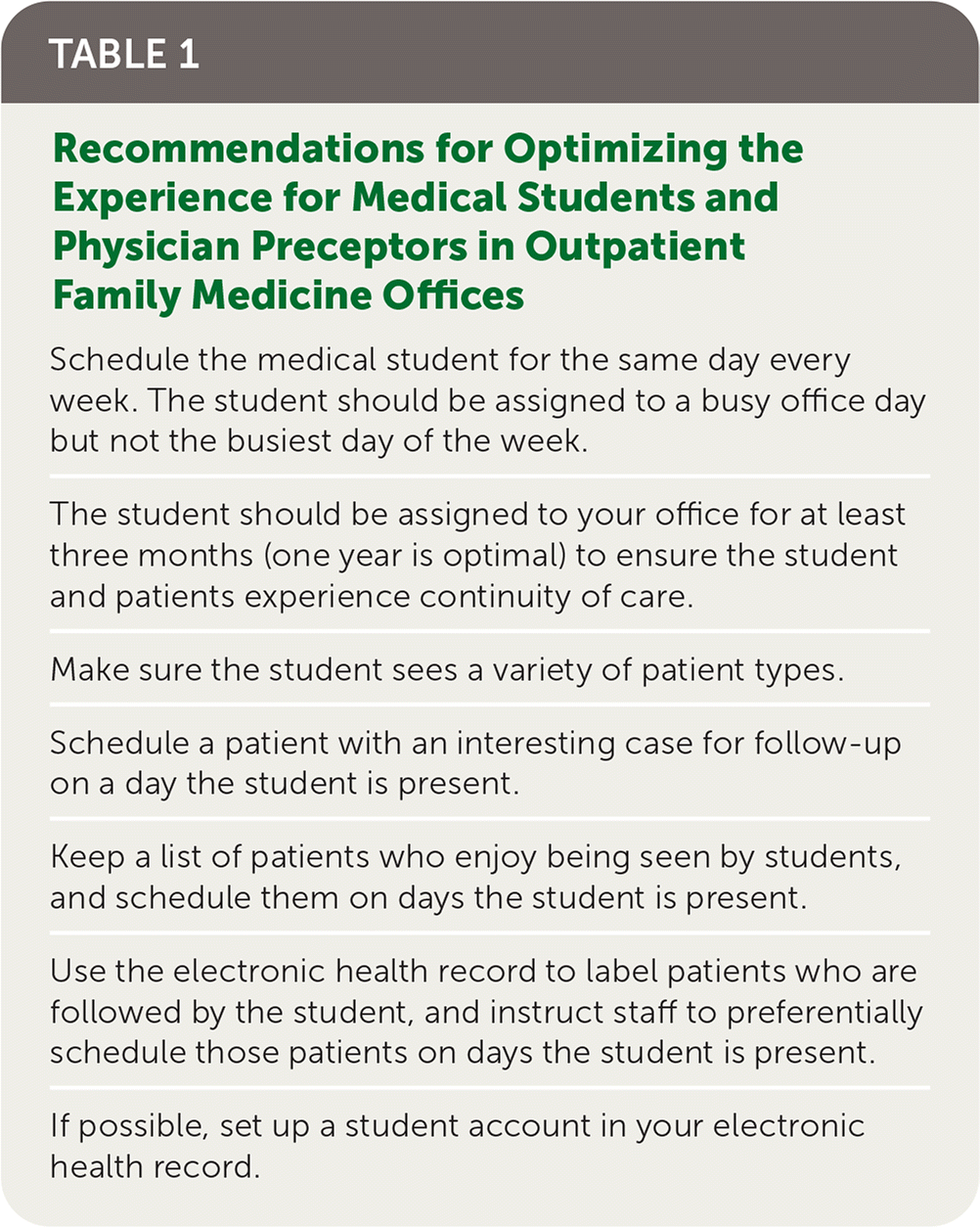
Am Fam Physician. 2020;102(3):140-141
Author disclosure: No relevant financial affiliations.
I am a community family physician seeing 20 to 30 patients daily. As with many primary care physicians, it is sometimes difficult for me to find time to teach medical students, but the benefits make it worthwhile. Teaching medical students truly improves my professional life, sharpens my clinical skills, and enriches my personal life. Teaching has strengthened my love of medicine and care for my patients. There is a need for more enthusiastic community family physician mentors to improve the shortage of medical students going into primary care and to reach the goal of 25% of students choosing family medicine by 2030.1,2 The need is more than I can meet alone, and I ask you to join me.
The pressure to provide quality care with increasing patient loads and documentation requirements can make physicians feel too busy to share their time with students. The financial stresses associated with the coronavirus 2019 pandemic and transitioning many visits to telehealth have created new challenges. Yet, teaching medical students is essential to the future of the profession. So why do community family physicians make time to share their knowledge and experience with the next generation? A study surveyed more than 100 physician preceptors about what motivates them to take the time to teach.3 The study showed that many preceptors want to help students become good physicians and are inspired to teach by their own mentors and experiences as a medical student. Some preceptors want the family medicine specialty to be appreciated by medical students and to ensure that false perceptions of the specialty are not perpetuated. Physician preceptors have a strong influence on their students' decisions to pursue primary care. My students see the continuity of care in my office and virtual visits and the bond and trust that develops between family physicians and their patients. This study also showed that many physician preceptors teach students because they want to challenge their own established views.3
Teaching medical students requires staying up to date on current medical treatments and being open to changing outdated practices. Seeing a student as a teammate helps everyone on the team learn, and I have found it can improve patient outcomes. Answering questions from novice learners often increases knowledge and benefits patients. A positive aspect of teaching medical students is that the student teaches us in return, whether it is alerting us to developments in medicine or reminding us of the excitement of those enthusiastic first steps in clinical medicine.
Many of us went into medicine because we love knowledge and the educational process. Nothing is more rewarding for an educator than to leverage a hard-won mastery of a subject by teaching it to future generations so that patients will benefit. Mastery creates an opportunity to share mental models that are not part of the medical curriculum but are essential to practice. Training future physicians on how to be successful at work and in their home life is as important as teaching them how to treat a critically ill patient. Mastery also creates efficiency, which allows more time for teaching the next generation. Because these future physicians will be taking care of us as we get older, we should make sure they are trained well, and we should encourage more medical students to go into primary care.
There is an increasing shortage of primary care physicians in the United States. In 2018, 30% of U.S. physicians were in primary care, and only 12% of these physicians were family physicians seeing outpatients.1 The America Needs More Family Doctors: 25 × 2030 Collaborative aims to increase the number of medical students choosing to practice family medicine to 25% by 2030.2,4 Reaching this goal will require more family physician preceptors to ensure that medical students have a favorable view of our specialty.
There are other benefits to teaching medical students. Some medical schools offer a stipend for teaching, although one survey found that only 23% of medical schools do this.5 Teaching medical students allows the educator to earn continuing medical education from the affiliated medical school. Physician preceptors also earn the title of teaching faculty, which can support career advancement.
For anyone considering becoming a community physician preceptor, Table 1 has recommendations to help you and your students get the most out of the experience.

| Schedule the medical student for the same day every week. The student should be assigned to a busy office day but not the busiest day of the week. |
| The student should be assigned to your office for at least three months (one year is optimal) to ensure the student and patients experience continuity of care. |
| Make sure the student sees a variety of patient types. |
| Schedule a patient with an interesting case for follow-up on a day the student is present. |
| Keep a list of patients who enjoy being seen by students, and schedule them on days the student is present. |
| Use the electronic health record to label patients who are followed by the student, and instruct staff to preferentially schedule those patients on days the student is present. |
| If possible, set up a student account in your electronic health record. |
